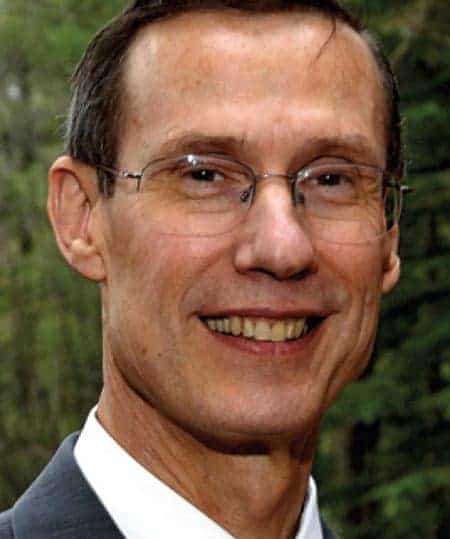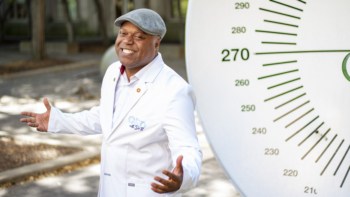Retired US Navy Vice Admiral Conrad C Lautenbacher Jr served as the administrator of the US National Oceanic and Atmospheric Administration (NOAA) from 2001 to 2008

What sparked your interest in physics?
I have always been fascinated with science, and when I was 12 or 13, I was fortunate to have teachers who encouraged this interest. My father also had an aptitude for science and mathematics; he was a naturally intelligent individual who left high school before graduating and became a dental technician because his family needed him to work — this was during the Great Depression. So I believe this interest is in my genes.
What led you to join the Navy?
I grew up in Philadelphia, and one of my teachers who had a son at the Naval Academy would read letters from him to the class. These letters fascinated me — they were full of adventure and excitement, with descriptions of places I had never seen. By the time I joined the Navy in 1960, students at the Naval Academy were allowed to choose a major subject, rather than focusing solely on a military and engineering curriculum, so I took every course I could in mathematics and physics. I graduated with a double major in both subjects in 1964, and then went to sea for four months on an aircraft carrier before beginning a programme leading to a PhD in applied mathematics at Harvard University.
How did you get into oceanography?
My Navy and science interests came together in the subject of fluid mechanics and I enrolled in a number of graduate-level courses in the subject. My PhD involved building tsunami models, which is an oceanographic application of this topic. In the late 1960s computers were still fairly primitive, so my model of how tsunamis run up onto islands used an IBM 7094, which required punch cards and had a memory that was probably smaller than your watch has today.
What are you working on now?
I spent many years in the Navy learning how to lead and manage large-scale operations, and I have just finished an eight-year spell as administrator of the US National Oceanic and Atmospheric Administration (NOAA), which has one of the largest research infrastructures of any single agency in the world — it even has people living at the South Pole recording atmospheric composition and investigating ozone-hole physics. Now I am working for the Computer Sciences Corporation and a subsidiary company, Antarctic Research Support, which is bidding for the next contract to support the US National Science Foundation’s work in Antarctica. Operating in Antarctica requires more than just scientists researching neutrino detection and ice-sheet mechanics — it also requires a unique and specialized support system. Antarctica has perhaps the harshest environment in the world and supply lines that stretch more than a third of the way around the Earth. Meeting the needs of daily living is an enormous challenge.
What are your views on climate change?
Whatever we do about climate change, we need to base it on sound science, which means investing in improved observing systems and obtaining climate-level data. As head of NOAA, I spent a lot of time organizing an international consortium to build a Global Earth Observation System of Systems (GEOSS) — including satellites and atmospheric-, ground- and ocean-measurement systems — so that, among other things, we can improve our understanding of climate dynamics. The models today are much better than the ones that existed a decade ago, but they are still not accurate enough to project very far into the future, and certainly not for 100 years from now. We know that the Earth has been warming, and we know that there are effects that, if extended, will cause significant problems. So we know enough to do something, but in my view the choice of what to do is a political question. As a scientist, I try to stay out of those kinds of debates.
What is your advice for physicists who want to tackle environmental problems?
First, work in a field associated with geosciences. For the future of the human species, we need more people who are interested in Earth sciences. The second thing is to think big. If we are going to solve the climate problem, or build a sustainable society, we need breakthrough scientific work. We have maybe a couple of generations to resolve these issues. I do not want to be negative — I am a glass-half-full person — but I do want to support the need for nations to invest more in Earth sciences and environmental education for the public. I reorganized NOAA in a way that aligned agency offices to mirror the relationships that exist among the Earth’s natural systems. It is counterproductive to isolate scientific disciplines such as meteorology, biology, geological surveying and so on — they are naturally connected by Earth systems’ dynamics. Earth scientists of all disciplines must talk to each other and break down the barriers of jargon and culture.
How do you feel your physics training has helped in your career?
Many people do not understand that physics is an important practical subject. Today’s world is highly technical. We cannot exist without the benefits of scientific discoveries — they are commonplace and everywhere around us. Physics has helped me in the same way that it helps everyone — the art of daily living requires both an appreciation and an understanding of scientific and physical processes. All of us must realize that the future of society depends on this technical world being supported properly, and also improved rapidly to reach the goal of a sustainable future for the human species.


